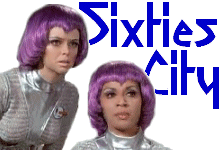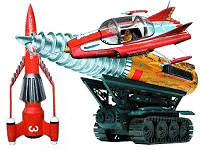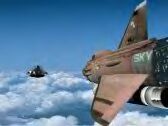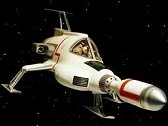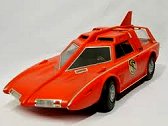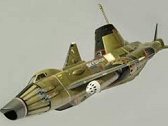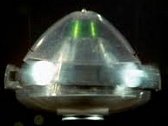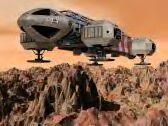|
|
|
1954 Devil Girl From Mars
Danziger Productions
  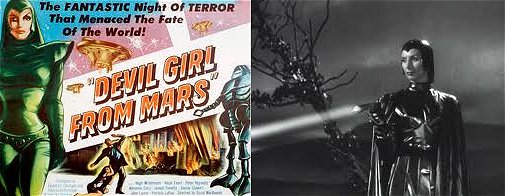
 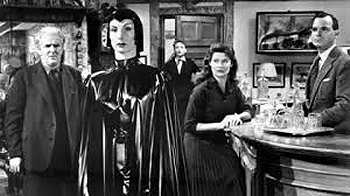
Sound editor (as
Gerald Anderson)
Devil Girl from Mars is a 1954 British black-and-white science fiction
film directed by David MacDonald and starring Patricia Laffan, Hugh
McDermott, Hazel Court, Peter Reynolds, and Adrienne Corri.
The screenplay was by James Eastwood, based on a play by John C. Mather
and Eastwood, and was produced by the Danziger Brothers. It was released
by British Lion and
released in the United States the following year. A female alien is
sent from Mars to acquire human males to replace their declining male
population.
When negotiation and intimidation fail she must use force to obtain
co-operation from the occupants of the remote Scottish village where
she has landed her damaged spacecraft.
The
film was made at Shepperton Studios on a very low budget, shot over
a period of three weeks.
1955 You've Never Seen This
Polytechnic
Films
 
 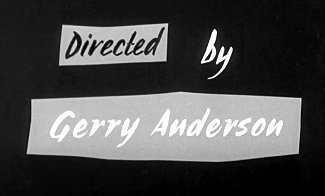
Directed
by Gerry Anderson
A 3-part pilot television
series that featured people doing strange things or with unusual
talents, featuring three items from Belgium - The art of `Tapis
de Sable' (sand painting) and the artist Pierre van Ransbeck;
a cyclist attempting to beat the cycling land speed record of 109
mph and an 8ft tall man showing Peter Collins (the producer) the
sights of Brussels, with Jon Farrell and Gay McGregor.
It was made for possible sale to the Independent Television Network.
Polytechnic films was based at Taplow, Bucks. and went into liquidation
in 1957. The series was never shown and so the title became a
self-fulfilling prophecy. From Polytechnic, AP Films was born, comprising
of five members of Polytechnic: Gerry Anderson, Arthur Provis, Reg
Hill, John Read and Sylvia Thamm.

1956 Kellogg's Cereals
Pentagon Films
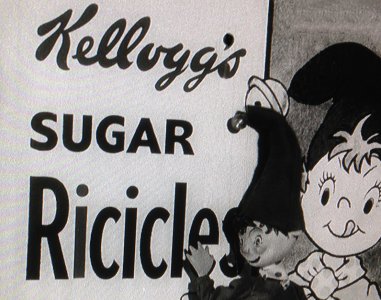
Director: Gerry Anderson (uncredited)
Director of Photography: Arthur Provis (uncredited)
Camera Operator: John Read (uncredited) Art
Director: Reg Hill (uncredited)
One
episode only, which featured the puppet character Noddy to advertise
Kelloggs Sugar Ricicles breakfast cereal, made at Pentagon's Berry
Hill studio using the original puppets

1957 - Martin Kane - Private Investigator (Private Eye)
Towers
of London / Ziv TV / ABC

39
x b/w 30min episodes Transmitted:
1958 - 59
Produced by Harry Alan Towers
Some episodes
directed by Gerry Anderson (no other information)
Starring
William Gargan and Brian Reece and originally titled 'The New Adventures
of Martin Kane'
Martin Kane (Gargan),
a New York private detective, assists Scotland Yard Superintendent
Page (Reece) from his London Base, in the classic 'cops and robbers'
style.
Made at the Associated British Pathe Company studios at Elstree.
 
1957 - The Adventures of Twizzle
Produced by AP FILMS for Rediffusion
Television

52 x b/w 15min episodes First
transmitted: 13th November 1957
Created and written by Roberta
Leigh Directed by Gerry Anderson
Art Director: Reg Hill
Twizzle
is a lost boy doll who lives in a place called Straytown with all
the other lost or unwanted toys including his friends Footso, the
black cat, Candy Floss, Jack-in-the-box and Jiffy the broomstick man.
They are looked after by the Toy Inspector. Twizzle has the strange
ability to be able to stretch his arms and legs to incredible lengths.
It is largely for Gerry Anderson's direction that the series is remembered,
even though he contributed to only the first 26 episodes. Made
at Islet Park studio on a budget of £450 per episode. 'Video
assist' was first used in this series, allowing production crew other
than the
cameraman to be able to see the shot in progress, a technique soon
widely adopted by the industry.
Sylvia Anderson recalls “we did not all dote on puppets as children
and have puppet theatre: the raw truth is that we needed the work
and that is all there was on offer.”
|
Twizzle And Footso
Twizzle And Footso Get Caught
Twizzle Saves The Doll
The Breakdown Van
Footso Is Stolen
Twizzle And The Golliwog
Jiffy And Chawky Quarrel
Footso Disappears
Twizzle And The Broken-Down Toy
Twizzle Builds Stray Town
A Flag For Stray Town
Jiffy's New House
Twizzle And Footso Go Fruit Picking
|
Twizzle
Has Some Fun
Twizzle And Candy Floss Open A Cake Shop
Twizzle Saves The Broken-Down Toys
Twizzle Gets Lost
Jiffy Opens A Barber Shop
Another Racing Car
Twizzle And His Friends Go To The Circus
The Toys Go To School
Bouncy The Ball
Jack-In-The-Box
Twizzle Catches Cold
The Naughty Girl
Jiffy's New Twigs
|
Twizzle
And The Snowman
Twizzle And The Thin Teddy Bear
The Lazy Broomstick Man
Twizzle And The Polly Moppet
Footso And The Magic Seeds
Jiffy And The Polly Moppet Quarrel
Footso Gets A New Tail
Twizzle Is Naughty
Twizzle Is Stolen
Chawky Gets A Present
Twizzle And The Toy Inspector
Twizzle And The Naughty Breakdown Van
Orange And The Banana Tree
|
Jiffy's
Birthday
Polly Moppet Disappears
Naughty Polly Moppet
Footso And The Naughty Girl
Stray Town Thief
Twizzle Papers The Cabin
Twizzle And Footso Go Camping
Twizzle Goes To The Seaside
Twizzle Goes To The Fair
Twizzle Goes Fishing
Twizzle Goes To The Zoo
Candy Floss's Birthday
Footso Has A Toothache
|

1960 - Torchy the Battery Boy
Produced
by AP FILMS for Pelham Productions Limited

2 series of 26 x b/w
15 min episodes First transmitted: 23rd February
1960
Created and written
by Roberta Leigh Series One directed by Gerry Anderson
Torchy,
a clockwork toy with a battery-powered light on his hat, travels
in his space rocket to and from Topsy-Turvy Land, where all the
neglected and mistreated toys live and come alive to join in his
adventures.
Other characters included Mr Bumble-Drop, King Dithers, Bossy Boots,
Pom Pom, Flopsy, Pilliwig, Sparky, Squish and Pongo. 3-Dimensional
sets were introduced for the first time on this series
and puppets were fitted with moving mouths and eyes. Roberta Leigh
went on to make a second series of Torchy with Associated British
Pathe.
|
Series
One
Pom-Pom And The Toys
Topsy Turvy Land
Torchy And Squish
The Building Of Frutown
Torchy And The Broken Rocket
King Dithers
Torchy Goes Back To Earth
Bossy Boots Goes To Topsy Turvy Land
Bossy Boots Is Taught A Lesson
A Bell For A Penny Farthing
A Trick On Pom-Pom
Torchy Is Stolen
King Dithers Loses His Crown
|
Pilliwig
Gets A Present
Bad Boy Bogey
Torchy And The Strange Animal
Bossy Boots Forgets To Be Good
Hungry Money Box
The Naughty Twins
The Twins Learn A Lesson
King Dithers Goes Down To Earth
Torchy Escapes At Last
Torchy And The Man In The Moon
Bogey And The Statues
The Moon Falls Asleep
Torchy's Birthday
|
Series
Two
Flopsy Goes On A Picnic
Torchy Gets A Surprise
Banana Bridge
King Dithers And Daffy
The Toys Get The Collywobbles
Bogey Learns Another Lesson
The Pollikan Bird Is Stolen
Torchy Has An Accident
Sparky The Dragon
Bogey Is Naughty Again
Pilliwig Cleans The Chimney
Pongo The Pirate
Pongo And The Gold Mine
|
King
Dithers' Birthday
Washing Day In Topsy Turvy Land
Gluebell Wood
Squish Falls Down A Well
Flopsy In Trouble
The Big Storm
Daffy's Birthday
Flopsy Makes A Christmas Pudding
Gilly Golly In Trouble
King Bumble Drop
A New Suit For Pilliwig
The Obstinate Donkey
Pom-Pom Gets The Hiccups
|

1960 - Four Feather Falls
Produced by AP FILMS
for Granada Television

39 x b/w 15 min episodes First
transmitted: 26th February 1960
Created by Barry
Gray Directed by Gerry Anderson
Sherrif
Tex Tucker saves the life of Makooya, the son of indian chief Kalamakooya
and is rewarded with four magic feathers which, among other things,
enable his guns to fire by themselves and allow
his dog, Dusty and horse, Rocky to be able to talk to him. The series
villains are Pedro the bandit and his sidekick Fernando.
Other main characters in the storylines were townspeople Martha
Jones, Grandpa Twink and Little Jake.
Barry
Gray created the concept for Four Feather Falls but he did not write
the first episode, 'How It Began'. This episode was actually written
by Mary Cathcart Borer.
The theme song was sung by Michael Holliday. Voice artists included
Kenneth Connor, Denise Bryer and David Graham. Glass fibre was used
for the puppets' heads for the first time
and electronic lip-synch was first tried. The pilot episode was the
last output of Islet Park studio. Production moved to a warehouse
on the Slough trading estate which became known as
the Ipswich Road studio. Arthur Provis left the partnership amicably
during this period, going on to work with Roberta Leigh on 'Sarah
and Hoppity' and another of her wonderful creations - Space
Patrol.
|
1.
How It Began
2. Kidnapped
3. Pedro Has A Plan
4. Pedro's Pardon
5. A Close Shave
6. Indian Attack
7. Sheriff For A Day
8. Dusty Becomes Deputy
9. Gunrunners
10. Trouble At Yellow Gulch
|
11.
Frame-Up
12. Gold Diggers
13. Gold Is Where You Find It
14. Trapped
15. Best Laid Schemes...
16. Escort
17. The Toughest Guy In The West
18. Chance Of A Ghost
19. Gunplay
20. A Lawman Rides Alone
|
21.
Jailbreak
22. A Little Bit Of Luck
23. Landgrabbers
24. Once A Lawman
25. Election Day
26. Gunfight On Main Street
27. A Bad Name
28. Horse Thieves
29. The Ma Jones Story
30. Bandits Abroad
|
31.
A Cure For Everything
32. Teething Troubles
33. Buffalo Rocky
34. Safe As Houses
35. First Train Through
36. Happy Birthday
37. Fancy Shootin'
38. Ambush
39. Ride 'Em Cowboy
|

1960 - Supercar
An AP FILMS production
in association with ATV for ITC worldwide distribution

39 x b/w 30 min episodes
in 2 series of 26 and 13 First transmitted: 28th
January 1961
Conceived by Gerry
Anderson and Reg Hill Produced by Gerry Anderson
Based
in a secret laboratory, Black Rock, in Nevada, Supercar is a prototype
vehicle invented by Doctor Beaker and Professor Popkiss which can
travel underwater, through the air and even into space,
piloted by Mike Mercury. Assisted by 10 year old Jimmy Gibson and
Mitch the monkey who they rescue, much of their time is spent thwarting
the villains Masterspy and Zarin who are trying to steal the
secrets of Supercar. There was a second series of Supercar - the first
26 episodes constituted season one (broadcast January to September
1961) while the last 13 comprised season two
(broadcast March to February 1962). The making of Crossroads To Crime
took place between the two seasons.
George Murcell was unavailable to voice Prof Popkiss in the second
series, which is why he was replaced by Cyril Shaps.
Supercar was one of the first British shows to be sold to America
by ITC, shown there in Autumn 1962. It was preceded by 'The Adventures
Of Robin Hood' which began on CBS in September 1955,
followed by 'The Adventures Of Sir Lancelot' (1955), 'The Buccaneers'
(1956), 'The Count Of Monte Cristo' (1956), 'The Four Just Men' (1957),
'The New Adventures Of Charlie Chan' (1957),
'The Adventures Of William Tell' (1957) and 'Danger Man' (1961).
There were a few 'firsts' - the first 30 minute series, Jimmy Gibson
was Sylvia Anderson's first voice part and the opening titles showing
Supercar flying through the clouds were the first time
back-projection was used. The term 'Supermarionation' was invented
for the promotional literature for the series to describe the lip-synch
procedure used in the puppets.
Episode
1 - Talisman of Sargon
Mike Mercury must foil Masterspy who, under the employ of an
unscrupulous Eastern potentate Mustafa Bey, attempts to gain
possession of the lost Talisman of Sargon, an ancient stone tablet
reputed to give absolute power to its owner.
Episode 2 - What Goes Up
Professor Popkiss is co-operating with the Air Force to send a
capsule of dangerous experimental rocket fuel into the stratosphere
so that it can be destroyed, but it fails to explode on the given
signal
from Earth.
Episode 3 - Keep It Cool
While taking a cargo of new secret fuel across the desert, the
Professor & Bill Gibson fall into the hands of Masterspy & his
henchman Zarin. Episode 4 - Rescue Bill & Jimmy are afloat at
sea
in a homemade raft when Mitch the monkey jumps overboard.
Mike wants to use Supercar to rescue them, but Doctor Beaker
insists on further tests.
Episode 5 - Amazonian Adventure
Because Mitch has been stricken with a strange fever, the Professor
& MIke use Supercar to seek a rare herbal cure found only near
the
Amazon, but they encounter a tribe of cannibals.
Episode 6 - Jungle Hazard
When Masterspy & Zarin read that Dr Beaker's cousin, Felicity
Farnsworth, has inherited a Malayan rubber plantation, they "visit"
her
plantation, but when the doctor learns she is in the clutches
of Masterspy,
he & Mike take Supercar to rescue her.
Episode 7 - High Tension
The plans of Mike Mercury, Dr Beaker & Prof. Popkiss are spoiled
by
2 thieves, Harper & Judd, who steal the printed circuits for a
remote
control unit for Supercar.
Episode 8 - King Kool
Mitch is jealous when he sees a monkey called King Kool playing
drums on television, so Jimmy decides to teach him to play the
drums
& form a rival act. Episode 9 - Grounded While Supercar is undergoing
repairs Masterspy & Zarin kidnap Dr Beaker. They inform Mike that
the
doctor will be returned in exchange for Supercar, but Mike formulates
a plan to rescue the doctor without losing Supercar.
Episode 10 - The White Lion
Baffled by a series of armored car robberies, Scotland Yard enlists
the
aid of Mike Mercury, Dr Beaker & Supercar.
Episode 11 - Transaltantic Cable
Masterspy has discovered a means of tapping the transatlantic
cable
that links the UK & the US, & he is selling valuable information
heard
over the phone. The phone company calls in Mike Mercury & Supercar.
Episode 12 - False Alarm
Masterspy & Zarin use a fake distress call to lure Supercar to
an isolated
mountain plateau where they plan to capture her & her passengers.
Episode 13 - Trapped in the Depths
After a bathyscape is launched from the USS Mistral for the deepest
underwater dive ever attempted, it sinks out of control off the
New Zealand
coast. |
Episode
14 - 70-B-LO
When the Professor undergoes a complex appendicitis operation,
he
urgently requires a transfusion of a rare blood type. The only
person known
to have this type is a scientist stationed at the North Pole.
Episode 15 - Gaolbreak
Racketeer "Red" James hires a helicopter to help a criminal escape
from
the state penitentiary, but when Supercar arrives on the scene,
he holds
Jimmy captive & demands that they be taken to Mexico in Supercar.
Episode 16 - Supercar; Take One
After Prof. Popkiss buys a movie camera to make permanent records
of
his experiments, Mike & Jimmy decide to make a movie of Supercar
& its
work, but there are some anxious moments when the film falls into
the hands
of Masterspy.
Episode 17 - Hostage
While on a holiday in Ireland, Dr Beaker overhears a plan by two
smugglers
to kidnap the daughter of the owner of the Shamrock Inn. He calls
for the help
of Mike Mercury & Supercar.
Episode 18 - The Sky's the Limit
Determined to gain possession of Supercar by any means possible,
Masterspy evolves a plan that he feels is certain to succeed in
capturing
the craft.
Episode 19 - Operation Superstork
Mitch unties a rope that is securing the Professor's latest project;
a
gas-filled balloon, & it takes off with Mike, Jimmy & Dr Beaker
aboard...
so it's up to Prof. Popkiss to fly Supercar & rescue them.
Episode 20 - Flight of Fancy
After reading that Princess Caroline of Bovania has been kidnapped
by
the evil President of the country & held prisoner in a medieval
castle,
Jimmy dreams that he & Mitch go to her aid.
Episode 21 - Crashlanding
When Supercar crashlands in darkest Africa, Mike Mercury & Dr
Beaker
decide to sleep until morning while Mitch stands guard...but in
the morning,
Mitch is gone.
Episode 22 - The Tracking of Masterspy
Using a counterfeit news agency card, Masterspy learns the location
of
Dr Beaker's isolated laboratory used for the testing & storing
of Supercar.
Episode 23 - Space for Mitch
When a rocket designed by Dr Beaker is going to be launched by
the US
government, Jimmy's brother is chosen to pilot the first flight.
Episode 24 - Hijack
When the President of the Bathtongas group of islands orders a
jet airliner
to be stolen & brought to his country & held for ransom, he reckons
without
Supercar.
Episode 25 - Atomic Witch-hunt
New York police are alerted when an atomic bomb is found in a
disused
block of office buildings. After they defuse it, they call in
the Supercar team
to discover how the bombs are being brought in to the city.
Episode 26 - The Dragon of Ho-Meng
After being caught in a hurricane, Supercar is forced to land
on a small island
in the middle of a lake close to a Chinese temple, but its devotees
think that
Supercar is a dragon! |
Episode
27 - The Runaway Train
Masterspy sabotages an experimental nuclear powered
train in an attempt to kill Dr Beaker, & in order to save
him, Mike must use an untested magnetic grab designed
to stop small vehicles.
Episode 28 - Calling Charlie McQueen
Prof. Popkiss receives a mysterious radio message in
a code used by radio operators in emergencies, but he's
not sure if it is a trap or not.
Episode 29 - Sunken Temple
Believing that an urn recently recovered from the
Mediterranean is from an ageless sunken temple, a
classical history professor enlists the aid of Mike Mercury
& Supercar to further his researches.
Episode 30 - A Little Art
When Dr Beaker buys a painting called "Mexican Plain"
he doesn't realise that two criminals have placed the
directions to the location of hidden counterfeit currency
plates on it...or that they will do anything to get it back.
Episode 31 - Magic Carpet
The Supercar team set out for Kirikan, an isolated
kingdom in southern Asia where rare medical supplies
are needed to save a prince's life.
Episode 32 - Icefall
When the Supercar team sets out for a day in the
mountains, Dr Beaker turns the simple outing into a
dangerous safari when he insists on investigating an
underground frozen waterfall.
Episode 33 - Precious Cargo
Prof. Popkiss orders some cooking wine from France,
but when the crate arrives everyone gets quite a surprise
from its contents.
Episode 34 - Deep Seven
While conducting an underwater experiment, Supercar
becomes entangled in the mooring cable of an old Army
mine, endangering Mike Mercury.
Episode 35 - The Day Time Stood Still
Dr Beaker, Prof. Popkiss, Jimmy & Mitch attempt to
keep Mike occupied while they make preparations for
his surprise birthday party.
Episode 36 - The Phantom Piper
Mike & Dr Beaker respond to a call from Scotland Yard to
investigate the phantom piper of Iverlachain, a ghost-like
figure that prowls the battlements of a medieval castle
playing the bagpipes.
Episode 37 - Pirate Plunder
A fast ship manned by Black Morgan, a descendant of
the famous pirate, has been plundering cruise ships in
the Pacific, & as Supercar is the only craft capable of
matching its speed, Mike is called in.
Episode 38 - Island Incident
Just after reading of a political revolution on the small island
of Paloda, Mike receives an anonymous distress signal
from that area.
Episode 39 - The Lost City
Forced off course during a journey to the South Pole,
Supercar & its passengers are forced to land in the ruins of
an ancient city.
|
The above information
is from the Sf-Lovers Archives at Rutgers University

1960 - Crossroads to Crime
AP FILMS / Anglo-Amalgamated

Film - b/w 57 mins Premiere:
November 1960
Produced by Gerry
Anderson 
A
young policeman, Don Ross, uncovers a plot by a gang of would-be
hijackers operating from a local cafe. He pretends to be corrupt
in order to try and foil their plans for a £20,000 hijack of
nickel alloy ingots.
The
first and only feature-length film to be directed by television
producer Gerry Anderson, and also the only feature-length film to
be made by his production company, AP Films.
Made between the two series of Supercar, this was a 'B' support
movie. Crossroads to Crime is often included in the syndication
package for the Edgar Wallace Mysteries
series but is an unrelated release, only included to help with sales.
Stars: Anthony Oliver, Ferdy Mayne, George Murcell, Miriam Karlin
and David Graham.

1960
- Blue Cars Holidays
AP
Films / Century 21 Productions (uncredited)
Commercials made
for Nicholas Parsons' production company on behalf of Blue Cars Holidays
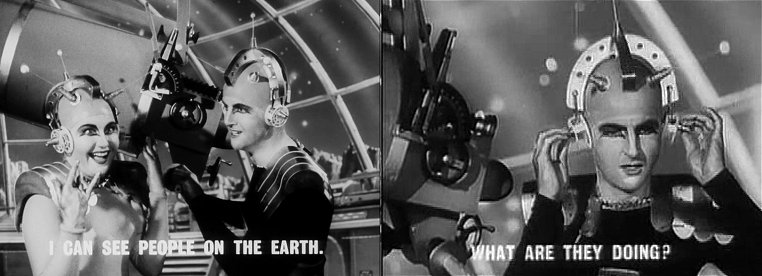
( 3
x 1 minute film sequences )
Producer:
Nicholas Parsons (uncredited) Script: Nicholas Parsons, David Ellis
(uncredited) Director: Gerry Anderson (uncredited)
Director of Photography: John Read (uncredited)
Art Director: Reg Hill (uncredited) Cast: Nicholas
Parsons, Denise Bryer (uncredited)
Also
made between the two series of Supercar. One of these, 'Martians',
won the Grand Prix prize in the Commercial Services category at
the first British TV Commercial Awards in 1961,
organised by the Television Mail. A second one, the 'French' one,
came third in the same category. ( Nicholas Parsons and wife Denise
Bryer pictured )

1962 - Fireball XL5
An AP FILMS production
in association with ATV for ITC worldwide distribution
39 x b/w 30 min episodes First
transmitted: 28th October 1962
Produced by Gerry
Anderson
Set
in 2063, Steve Zodiac is the pilot of Fireball XL5, the flagship
of the fleet of the World Space Patrol, based in galaxy sector 25.
In his crew are the blonde, curiously un-surnamed
space doctor Venus, bespectacled Professor Matthew Matic, the transparent
robot Robert and alien 'pet' Zoonie the Lazoon.
The
first series to use the concept of a world class organisation combatting
evil and the first British children's television programme to be
taken up by an American network.
Transmitted by NBC Television in 1962. This was the only show ever
to contain a Gerry Anderson-voiced character, albeit unrecognisable
as Robert the robot!
AP FILMS were sold to Lew Grade at ATV in 1962, prior to the production
of Stingray and the studios moved to larger premises at Stirling
Road on the same estate.


May 1963 - Wall's and Lyons Maid Ice Cream Tie-Ins 'Zoom', 'Sea Jet',
'FAB', 'Super Sea Jet', 'Orbit' and 'Smash'
J.Lyons & Co.

   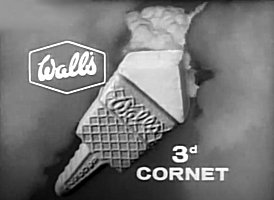
1961 Supercar
was featured in a Wall's ice cream cornet advert
April / May 1963 'Zoom'
was a 'Lyons Maid' ice rocket in three flavour stages: lime, lemon
and strawberry. It was one of the first ice lollies advertised
on television and in cinemas.
Lyons engaged Gerry Anderson to make the colour commercials, featuring
Fireball XL5 and Colonel Steve Zodiac, resulting in its becoming
a best-seller. Thunderbirds and
Joe90 were also later used to promote 'Zoom'. 'Sea Jet and
'Super Sea Jet' lollies were also produced and a number of advertisements
starring Stingray were made to promote the 'Sea-Jet'
ice lolly. 'Sea Jet' was available in four flavours vanilla, strawberry,
lemon and orange. The 'Super Sea Jet' (which cost 2d. more) had
three flavours in one, mint and vanilla dipped in chocolate.
May 1967 saw the launch of the legendary 'FAB', with its
Thunderbirds and Lady Penelope tie-ins. Designed for girls in
the 5-15 age group, the 'hundreds and thousands' sprinkled
on top of a chocolate tip were intended to give it a feminine
and sophisticated look. The lolly itself consisted of strawberry
and vanilla ice with the top portion dipped in chocolate.
May 1968 'Orbit' was a rocket shaped lolly tied in to Captain
Scarlet and The Mysterons. It somewhat resembled 'Zoom' but was
chocolate and orange flavoured.
March 1969 A new range of 4d ice lollies were launched, called
'Smash', available in four flavours: orange, strawberry, banana/chocolate
and strawberry/vanilla.
Advertising was tied in to the Thunderbirds TV programme and the
launch was linked to a promotional camera offer.
The 'Super Sea Jet' was also re-launched in two versions: raspberry/orange
and strawberry/vanilla with a choc-dipped nose cone.
March 1972 'Zoom' relaunched as 'Super Zoom'
March 1976 'Space 1999' was launched at a price of 7p, a lime,
vanilla and strawberry flavoured lolly with a soft centre and
a picture card in each pack.
J.Lyons
& Co
 This
is a near complete collection of the original 1960's Supermarionation
commercials for Walls, Lyons Maid & Kellogg's. This
is a near complete collection of the original 1960's Supermarionation
commercials for Walls, Lyons Maid & Kellogg's.

1964 - Stingray
An AP FILMS production
in association with ATV for ITC worldwide distribution
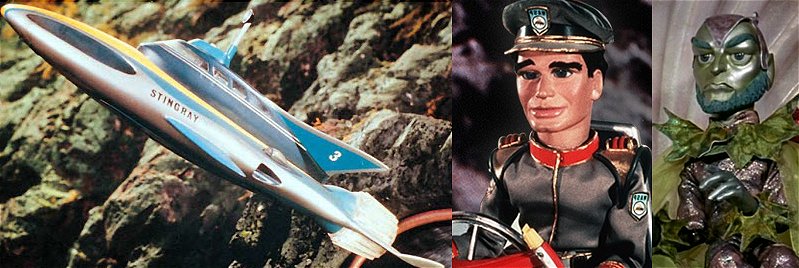 


39 x colour 30 min episodes First
transmitted: 4th October 1964
Produced by Gerry
Anderson
Set
in the year 2064, Stingray, an advanced submarine belonging to W.A.S.P.
- the World Aquanaut Security Patrol - is crewed by pilot Troy Tempest
and hydrophones operator Lt. George 'Phones' Sheridan.
They are assisted by the underwater-breathing Marina, rescued from
Titanica by Troy in the first episode. Her father is Aphany, ruler
of the undersea kingdom of Pacifica. In between fighting the terror
fish of the
evil Titan and his amphibians and outwitting their agent X20, Troy
is caught in the eternal triangle with the non-speaking Marina and
Atlanta, the daughter of Commander Shore, head of their Marineville
base.
Stingray was the first series in which episodes were filmed simultaneously
by crews working on two completely separate soundstages with duplicated
sets and puppets.
On Fireball XL5 the limited studio space meant that the two crews
shared the facilities on a single soundstage and moved between the
sets on a definite rota.
No
pilot episode was made for this series as it was directly ordered
by Lord Lew Grade. This was the first children's series made entirely
in colour ( for the American market, although 30 episodes
of 'The Adventures of Sir Lancelot' were made in colour in 1955).
First shown on British TV in black and white, the colour process
used was christened ' Videcolor'.
Probably most remembered for the haunting end theme 'Aqua Marina',
a chart hit sung by Gary Miller and written by Barry Gray.
The 'Stingray' craft was designed by Reg Hill.

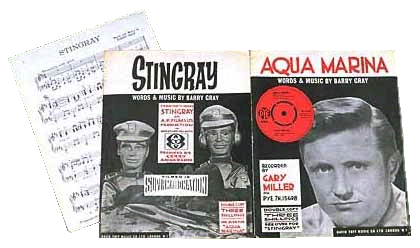
 
1965 - Thunderbirds (series 1 )
AP FILMS / ITC


Series 1 - 26 x 50 min
episodes First transmitted: Thursday 30th September
1965
Producer: Gerry
Anderson Associate Producer: Reg Hill

Set
in 2065, the Tracy family, operating from their secret Pacific Ocean
island base as International Rescue, save the world from disasters
of various sorts using the inventions of Hiram 'Brains' Hackenbacker.
Dad - Jeff Tracy - ex lunarnaut - is the boss and the various craft
are piloted by his sons Scott (TB1), Virgil (TB2), Alan (TB3), Gordon
(TB4) and John (TB5), with assistance at various times from their
faithful
manservant Kurano and his daughter TinTin. Also helping is their
glamorous British agent, Lady Penelope Creighton-Ward and her chauffeur
Aloysius 'Nosey' Parker in the fabulous six-wheeled pink
Rolls-Royce FAB 1. Amongst their many problems is the master criminal
'The Hood', who is constantly trying to discover their secrets.
AP Films had been shooting episodes simultaneously since Fireball
XL5. Without this, a shooting schedule of two weeks per episode
would have taken 18 months to film Fireball XL5 and another 18 months
to film Stingray, whereas both series were actually completed in
half that time. For the 50 minute-long Thunderbirds episodes the
schedule for each was expanded to four weeks, but with simultaneous
shooting the first season 26 episodes were completed in just over
a year.
Thunderbirds
was not a success in America, which is why the show was cancelled
early and a new show commissioned. It was not shown in the U.S.A.
until 1968, after a greater success by Captain Scarlet.
The Tracy boys are all named after real-life astronauts. The pilot
episode 'Trapped in the sky' was only 25 minutes long but expanded
to 50 minutes on the orders of Lew Grade.
This helped to improve the storyline and character development.
The 'Roller-road' was first conceived and used during the series
for ground vehicle motion shots.
Each episode of Thunderbirds contained, on average, 100 SFX shots.
This was also the first series not to be screened in a childrens'
TV slot.


1965 - Concorde
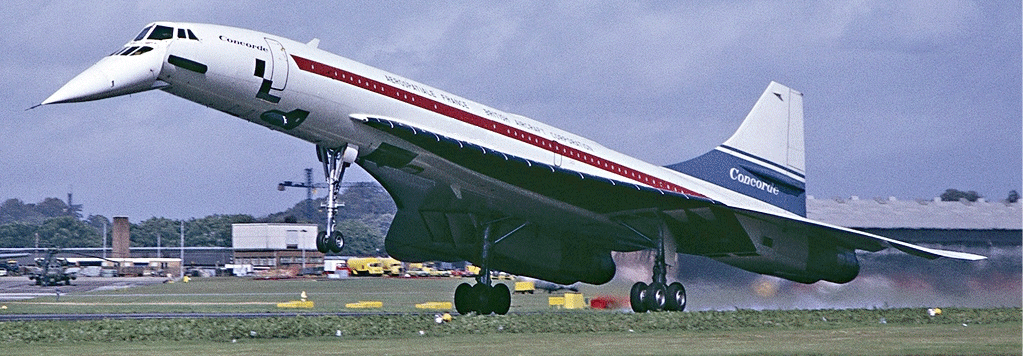
Footage
of a model Concorde taking off was produced for British Airways
to use in a documentary. When the Concorde made its maiden flight
to Toulouse, France,
to be unveiled, it was greeted by the Band of the Royal Marines
striking up Barry Gray's 'Thunderbirds March'.
No
other information available.

1965 - TV Century 21 Paper and Century 21 Records
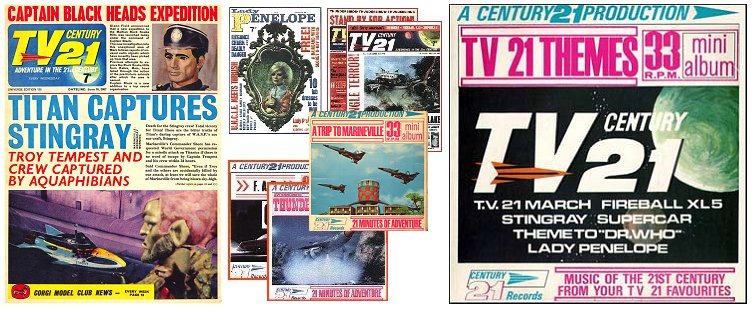 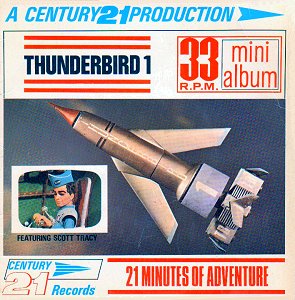
The
year also saw the launch of the high quality, glossy TV Century
21 comic on Wednesday 23rd January. Published by City magazines
and Century 21 publishing ( AP Films Merchandising ),
it was conceived by Keith Shackleton and edited by Alan Fennell,
followed a year later by a sister paper, 'Lady Penelope'. Combined
circulation reached a peak of 1.3 million copies per week.
Also launched, in September, was Century 21 records - Clive Selwood
and Gerry Anderson in partnership with PYE records. These 33 r.p.m.
mini albums - "21 minutes of adventure"
featured original material, abridged versions of some of the shows
and the wonderful music of Barry Gray. 36 were produced in all:
1
x Fireball XL5, 3 x Stingray, 5 x Captain Scarlet, 4 x Theme and
Incidental music, 19 x Thunderbirds of which 3 were original new
stories.
4 others contained licensed properties including Doctor Who and
Topo Gigio

1966 - Thunderbirds Are Go
Century 21 Cinema /
United Artists
 
  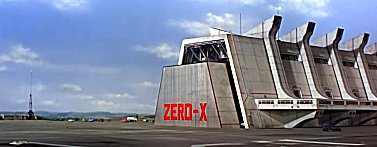
Film
- 94 minutes
Executive
Producer: Gerry Anderson Producer: Sylvia Anderson
Premiered at The London Pavilion, Leicester Square, Monday 12th
December 1966

On
the big screen for the first time, International Rescue supervise
the security arrangements surrounding the launch of the 'ZERO X'
manned Mars mission.
Problems arise when it runs into trouble on the return journey.
It uniquely
features Cliff Richard and The Shadows in puppet form, performing
at the 'Swinging Star' night club which Alan Tracy and Tintin visit.
The puppets were stars at the premiere. This was the first attempt
by a British TV company to get into the cinema film business.
The film was actually called 'Thunderbirds Are Go' - no ! mark,
which can clearly be seen on the E.P.!


1966 - Thunderbirds ( series 2 )
AP FILMS / ITC

6
x 50 minute episodes First transmitted: October
2nd 1966
Producer:
Reg Hill Executive
Producer: Gerry Anderson Associate
Producer: John Read

This
series - set in 2067 - brings us more action, adventure and bravery
from the Tracy boys and their expensive toys. Even more spectacular
special effects and strange mechanical devices.
Thunderbird 3 was apparently based on the Russian Soyuz craft. You
may also note a similarity in the shape of sections of the Tracy
homestead and the design of Thunderbird 5, their orbiting monitor
station.
In
1966 Gerry Anderson received television's highest award,
The Silver Medal for Outstanding Artistic Achievement from
the Royal Television Society.
 
  
|
|
|
